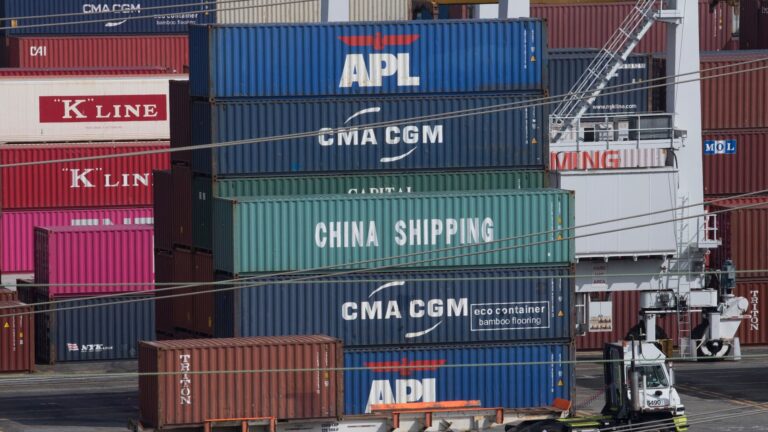The truck passes through a shipping container in the Port of Los Angeles.
Mark Ralston | AFP | Getty Images
New waves of marine cargo from China are beginning to arrive at Los Angeles Port and Long Beach. President Trump has placed an August 12 deadline for the US and China to agree to a trade agreement.
More recently, ship tracking services managed by Southern California and the Coast Guard's marine exchange showed increased ship arrivals on Friday (64), Saturday (68) and Sunday (64).
“This is a very strong forecast that container ship arrivals will increase over the next one or two weeks,” said Captain J. Kipling (KIP) Louttit, executive director of MX SoCal. He said it was the most container ship on its way to the busiest port in the country since January 2025 (previously highs were in July and September 2024).
Forecasts for the coming weeks include the average of container ships coming from Asia over 16 days, container ships coming from Oakland and San Diego per day, the Panama Canal, South America, Mexico, Hawaii and Alaska, and transit times between them.
An increase in containers was expected, and authorities stopped referring to it as a “surge.” There are no sustainable high levels of predictions. After a few weeks of order growth, pre-orders for marine cargo have declined. Due to the recent softness of container traffic, there is no prediction of congestion at West Coast Port. The trade war led many US importers to pause on orders, arriving at the ports of Los Angeles and Long Beach before the New Wave was full.
The Long Beach Port terminal operates at approximately 60% of its capacity. Mario Cordero, CEO of Long Beach Port, told CNBC the port is well prepared to handle the expected rise in vessel traffic over the coming weeks.
Cancelled Sailing in Long Beach – many shippers cancelled cargo ship voyages planned earlier this year in the early stages of Trump's trade war – has now only four from the expected 18 in June to July and August totals, Corrello said.
“We are looking forward to coordinating closely with terminal operators, labor and other partners to increase the flow of cargo, so we have what we need. We welcome additional cargo and look forward to solving trade policy issues that have led to extremely uncertainty for shippers,” he added.
The Port of Los Angeles terminal operates at 70% of its capacity. Port of Los Angeles Executive Director Jean Seloka noted in a monthly container update that ports can see signs of peak season orders upon arrival in July. However, he added: “Retailers aren't saying they're increasing stock levels to start that Thanksgiving week and have a wide selection of products that run through the end of the year, so I haven't seen that either.”
The Port of Los Angeles terminals are operating at less than 30% of the dock's cargo today than during peak hours during Covid. “We have plenty of space to manage the cargo,” Seroka said in the update.
The currently arriving vessels are expected to fill up. This increase in containers will be a boost to trucking, rail and warehousing companies paid for by freight loads.
Celoka told CNBC that the increase in cargo in recent weeks compared to May “has brought more people back at our docks.”
He added that freight flows are still below normal for June and “there are the imminent deadlines for trade negotiations in July and August, which will affect the volume forecast for the rest of the year.”

